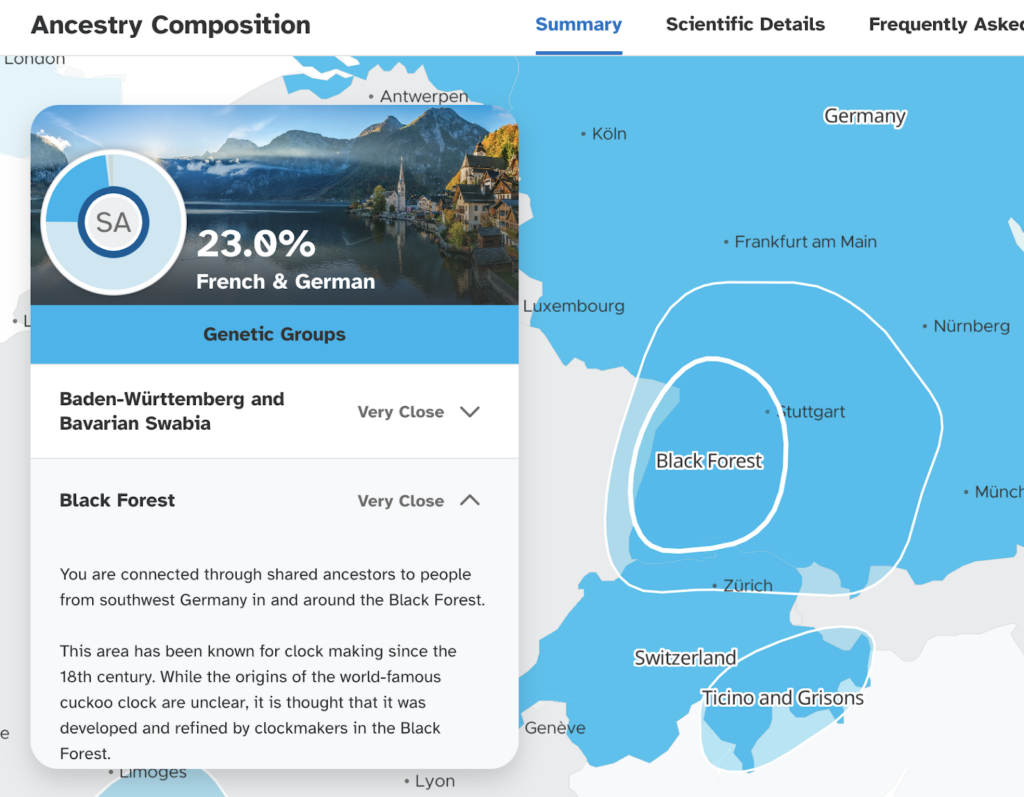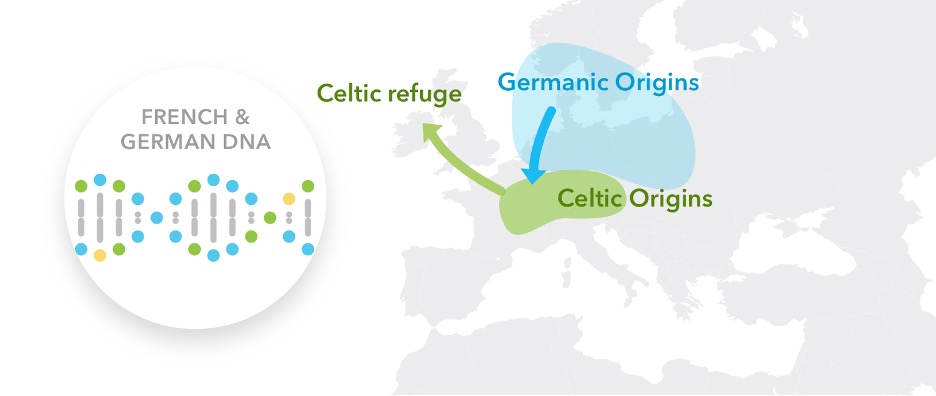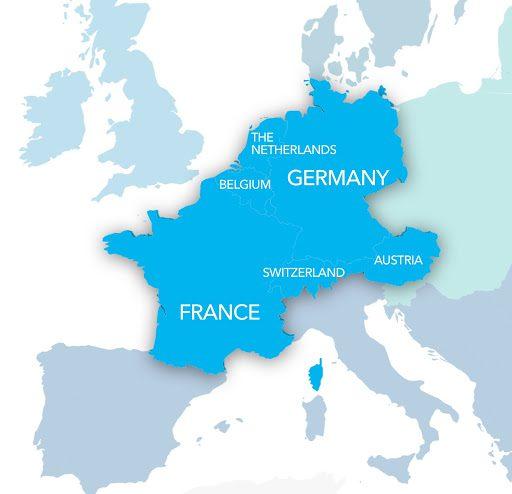Simply saying one has German ancestry doesn’t capture how diverse the cultural, linguistic, and historical differences are within the country of more than 80 million people.
Germany has over 16 administrative districts and at least a dozen distinct dialects. Someone from the North along the Baltic Sea who speaks what is called Plattdeutsch might have difficulty understanding someone from part of Bavaria who speaks Schwäbisch, for instance.
Distinct Populations
Beyond Germany, there are also distinct populations within Switzerland, the Netherlands, Austria, Luxembourg, and France with Germanic ethnolinguistic roots.
To better reflect those differences and improve the granularity of 23andMe’s Ancestry Service, 23andMe added 49 different genetic populations in Germanic Europe. Those include 20 in Germany, 10 in Switzerland, eight in the Netherlands, 10 in Austria, and one in Luxembourg.

Example results of a customer with matches to new Germanic Genetic Groups.
This update closely follows the recent addition of 36 Genetic Groups in France and Belgium, offering those with roots that trace back to these regions of Europe.
Germanic Europe
To better understand this Germanic Europe update, it’s helpful to understand the origins of modern-day Germanic peoples of Western Europe. They are descended from ancient Alpine-Celtic and Germanic populations and inhabit an area extending from the Netherlands to Austria—roughly corresponding to the extent of Charlemagne’s Frankish Kingdom in the Middle Ages.
Genetically and geographically, Germanic peoples are at the heart of Europe.

Map showing the ancient, broad ethnic groups that influenced modern Germanic ancestry.
Germanic people have lived at a crossroads in human migration for millennia, and their genetics reflect that history. Celtic languages and culture first appeared in Central Europe, extending from the British Isles to the Black Sea by the Third century BCE. However, the rise of the Roman Empire spelled the downfall of a Celtic-speaking Europe, and today, Celtic languages are only spoken along the far western periphery of their former territory.
With the decline of the Western Roman Empire, Germanic tribes conquered vast territories from the North Sea to North Africa. Although Germanic languages did not replace the Latin-based languages spoken in what is now France and Belgium, recent studies found evidence that the migrations of Germanic peoples from the 4th to the 6th centuries had a more significant impact on Europe’s DNA than did the earlier expansion of the Roman Empire.
Ancestry Composition update
The update is part of our continuing work to improve 23andMe’s Ancestry Service reports and features. This new update allows customers with ancestry tracing to one of these countries to see their genetic connections to these communities.
23andMe’s Ancestry Composition report is a living analysis that improves as we add new reference data. Underlying our Ancestry reports are powerful algorithms and analytical tools developed by 23andMe population geneticists and engineers to offer our customers more insights into their ancestral origins.
Over the last few years, we’ve updated results to allow our customers to see more detail about their connections to specific geographic regions that correspond to cultural and linguistic regions.
Find out more
23andMe customers can see their Ancestry Composition.
Not yet a customer? Find out more about 23andMe’s Ancestry Service and other services.
Regions in Germanic Europe covered in this update
Below is the list of 23andMe’s 49 Germanic Genetic Groups:
Germany
Eastern Bavarian Highlands – People from southeastern Germany, particularly near the Thuringian and Bohemian Forest, extend down to the foothills of the Bavarian Alps. For centuries, the Bohemian Forest acted as a natural border between Bavaria and Bohemia (now Czechia, or the Czech Republic), which helped shape the distinct cultural identities of these regions. Some people in this Genetic Group say their recent ancestors spoke Bavarian or Eastern Franconian, distinct German dialects standard in southern and northern Bavaria.
Southeastern Bavaria– People from southeastern Germany, particularly around the Isar and Danube Rivers, between the Bavarian Alps and the Bohemian Forest.
Upper and Middle Franconia —This genetic group includes people from east-central Germany, mainly Upper and Middle Franconia. However, some report ancestors from the foothills of the Fichtel and Ore Mountains further east.
Lower Franconia – People from central Germany, particularly in Lower Franconia near the foothills of the Rhön Mountains.
Saxony and the Thuringian Basin – People from eastern and central Germany, particularly between the Harz and Ore Mountains.
Baden-Württemberg and Bavarian Swabia – People from southwestern Germany, ranging from the Rhine River valley to the Black Forest to the Swabian Alps. Many people in this Genetic Group say their recent ancestors spoke Swabian, a distinct German dialect known for its unique vocabulary, pronunciation, and grammar.
Greater Allgäu – People from south central Germany between Lake Constance, the headwaters of the Danube River, and the Lech River.
Black Forest – People from southwest Germany in and around the Black Forest.
Central Swabia – People from central Swabia, mainly north of the Swabian Jura mountain range in Baden-Württemberg. Historically, this region was influenced by ancient kingdoms such as the Alemanni (part of the Suebi Germanic peoples, from which the region gets its name) and later the Duchy of Swabia, which have left a lasting imprint on its cultural landscape.
Main River Basin – People from the center of Germany, along or near the course of the Main River, from northwestern Bavaria to its confluence with the Rhine River near Mainz.
Rhine-Main region – People from southwestern Germany, particularly from the Rhine-Main metropolitan region, centered around the confluence of the Rhine and Main rivers near the foothills of the Rhön Mountains.
Eastern German Plains – People from the eastern plains of Germany, ranging from the Harz Mountains in the southwest to Poland and the Baltic Sea in the east and northeast.
Rhineland – People from western Germany, particularly on the west side of the Rhine River, a region historically referred to as the Rhineland or Rhinelands.
Rhine-Ruhr Region – People from central west Germany, particularly near Cologne (Köln), Düsseldorf, and the “Ruhrgebiet” — a large urban region that includes Dortmund, Essen, and Duisburg, among other cities.
The Ruhrgebiet, Teutoburg Forest and the Westphalian Highlands – People from the Sauerland and Siegerland regions of the Westphalian highlands, the Teutoburg Forest in eastern Westphalia, and the “Ruhrgebiet” — a densely populated urban zone encompassing cities such as Dortmund and Essen.
Northwestern German Plain – People from the northwestern plains of Germany, spanning parts of the western portions of Lower Saxony and North-Rhine Westphalia, roughly between the Ems River in the west and the Weser River in the east.
Northern Germany – People from northern Germany, particularly the southern part of the Jutland Peninsula and around the Elbe and Weser Rivers.
Elbe-Weser Triangle – People from northwestern Germany, particularly from Bremen and the Elbe-Weser Triangle — a region between the Elbe and Weser Rivers near the North Sea.
German Jutland – People from the southern part of the Jutland Peninsula, particularly north of the Elbe River. This region was long disputed between Denmark and Germany.
Westphalian Lowlands – People from the Westphalian Lowlands of western Germany, north of the Rothaar Mountains.
Luxembourg
Guttland – People from Guttland or Bon Pays (“Good Land”) – Luxembourg’s southern and central region, nestled between France and Belgium to the south and west and the Moselle River and Germany to the east. Guttland contains most of the country’s population and is the economic powerhouse of Luxembourg.
Switzerland
Bernese Alps and Central Swiss Plateau – People from the central region of the Swiss Plateau, including the canton of Bern. Known as the Mittelland, the Swiss plateau stretches from the southern slopes of the Jura mountains to the northern tip of the Berner Oberland (or Bernese Highlands), which is home to the breathtaking waterfalls of Lauterbrunnen Valley and the highest peaks in the Bern canton, including the iconic trio of Eiger, Mönch, and Jungfrau.
Northeastern Aare Basin – People from the northeastern portion of the Aare River basin, centered on the present-day Swiss canton of Aargau (meaning “Aare province”) and extending toward Zürich to the west.
Eastern Jura Mountains – People from the eastern region of the Jura Mountains — where the borders of Switzerland, France, and Germany meet — including the present-day Swiss city of Basel.
Ticino and Grisons – People from the Italian- and Romansh-speaking regions of Switzerland and northern Italy — particularly the southeastern cantons of Ticino and Grisons — although some also report ancestors in the northwest Swiss canton of Jura.
Limmat Valley and Schaffhausen – People from Zürich and the surrounding Limmat River Valley, as well as from the northern Swiss canton of Schaffhausen.
Lucerne, Kleine Emme Valley, and Seetal – People from central Switzerland, particularly the canton of Lucerne.
Muota Valley – People from the Alpine foothills that surround Lake Lucerne, including the Muota Valley (Muotathal) and extend into the modern-day cantons of Zug, Schwyz, Uri, Nidwalden, and Obwalden.
Pennine Alps – People from the foothills of the Pennine Alps in southern Romandie (French-speaking western Switzerland), in the modern Swiss canton of Valais, situated on the border with France and Italy.
Thur Valley and Appenzell – People from the Thur Valley in northeastern Switzerland, stretching from Walensee (Lake Walen) at the southern border of St. Gallen canton to Bodensee (Lake Constance) along the northern Swiss border and extending into neighboring Austria, Lichtenstein, and Germany.
Western Swiss Plateau – People from the western Swiss Plateau, centered on Vaud canton in the French-speaking Romandie region of western Switzerland and stretching from Lac de Neuchâtel in the north to Lac Léman (Lake Geneva) in the south.
The Netherlands
Utrecht and Gelderland — People from the central Netherlands, from Arnhem in the east to Amsterdam in the west, with Utrecht at its heart. Connected by a section of the lower Rhine and the Amsterdam-Rhine canal (the world’s most heavily trafficked artificial waterway), this region includes the northeastern edge of the Randstad — a densely populated crescent-shaped urban belt — and parts of western Gelderland.
Friesland and western Groningen — People from Friesland span from the Ijsselmeer (Lake IJssel) to western Groningen in the northern Netherlands. Frisian, a West Germanic language natively spoken by most of this region’s population, is closely related to English and is recognized as an official language in the Netherlands alongside Dutch.
Zuidvleugel and Groene Hart—People from Groene Hart and the neighboring Zuidvleugel—the “south wing” of a region known as the Randstad, a densely populated, crescent-shaped urban belt spanning from Rotterdam to Amsterdam and beyond in the western Netherlands.
Groningen and northern Drenthe — People from Groningen and northern Drenthe in the northeastern Netherlands, spanning parts of the ancient Germanic Frisian and Frankish Kingdoms. Notably, this region is home to almost all of the Netherlands’ megalithic archaeological sites, in particular the <i>hunebedden</i> or dolmens — large burial monuments composed of massive boulders that were constructed by the Funnelbeaker people who lived here around 5,000 years ago.
Noord-Brabant and Limburg – People from the Dutch states of Limburg and Noord-Brabant in the southeastern Netherlands, south of the Netherlands’ three major rivers (the Maas, Waal, and Rhine). Researchers have found a distinct genetic border roughly separating Noord-Brabant and Limburg from the rest of the Netherlands.
North Holland Peninsula – People from the North Holland peninsula, primarily between Haarlem and Amsterdam in the south to Den Helder in the north.
Central East Netherlands – People from Overijssel, southern Drenthe, and northern Gelderland in the eastern Netherlands.
Zeeland and South Holland – People from Zeeland and parts of South Holland near the Rhine-Meuse and Scheldt deltas.
Austria & Germanic Peoples in Slovenia
Greater Güssing — People from southern Burgenland along Austria’s border with Hungary, particularly the town of Güssing.
Carnic and Gailtal Alps — People from southern Austria, centered on the Carnic and Gailtal Alps along the border with Italy and stretching east into the Karawanks along the border with Slovenia, in what is now the Austrian state of Carinthia (Kärnten).
Oberösterreich and the Danube Valley – People from northern Austria, stretching from the western border with Germany through the modern state of Upper Austria (Oberösterreich) and encompassing parts of the Danube River valley.
Eastern Austrian plains—People from the eastern plains of Austria, including parts of the modern-day states of Lower Austria, Vienna, Burgenland, and Styria. This region stretches from Vienna—Austria’s culturally vibrant capital city—to Graz, Austria’s second-largest city, situated along the Mur River in Styria.
Western Austrian Alps – People from western Austria, stretching from Lichtenstein and eastern Switzerland through the Austrian states of Vorarlberg and Tyrol.
Karawanks – People from southern Austria and northern Slovenia, centered on the Karawanks and the southern Austrian city of Klagenfurt am Wörthersee.
Ljubljana Basin – People from the Ljubljana Basin in central Slovenia.
Mur Valley and Salzburg—People from central Austria centered on the Mur Valley in Styria, stretching from Salzburg near the border with Germany to Wolfsburg in the south.
Rinza Valley – People from southern Slovenia and northern Croatia, especially the Rinza Valley, including the Slovenian town of Ko?evje.Vienna and Northeast Austria – People from northeastern Austria, extending from Vienna west into Lower Austria (Niederösterreich) and south into the Mürz River Valley.




